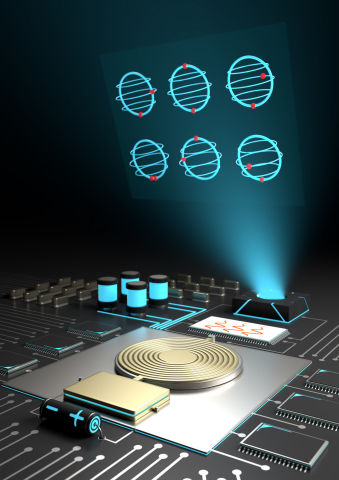In a new work published in Nature Electronics, researchers in Finland have developed a circuit that produces the high-quality microwave signals required to control quantum computers while operating at temperatures near absolute zero. This is a key step towards moving the control system closer to the quantum processor, which may make it possible to greatly increase the number of qubits in the processor.
This press release features multimedia. View the full release here: https://www.businesswire.com/news/home/20211209005593/en/

Artistic impression of an on-chip microwave source controlling qubits. Credit: Aleksandr Kakinen.
One of the factors limiting the size of quantum computers is the mechanism used to control the qubits in quantum processors. This is normally accomplished using a series of microwave pulses, and because quantum processors operate at temperatures near absolute zero, the control pulses are normally brought into the cooled environment via broadband cables from room temperature.
As the number of qubits grows, so does the number of cables needed. This limits the potential size of a quantum processor, because the refrigerators cooling the qubits would have to become larger to accommodate more and more cables while also working harder to cool them down – ultimately a losing proposition.
A research consortium including Aalto University, VTT Technical Research Centre of Finland, and IQM Quantum Computers has now developed a key component of the solution to this conundrum. ‘We have built a precise microwave source that works at the same extremely low temperature as the quantum processors, approximately -273 degrees,’ says the team leader Mikko Möttönen, Professor at Aalto University and VTT Technical Research Centre of Finland and a Co-Founder and Chief Scientist of IQM.
The new microwave source is an on-chip device that can be integrated with a quantum processor. Less than a millimetre in size, it potentially removes the need for high-frequency control cables connecting different temperatures. With this low-power, low-temperature microwave source, it may be possible to use smaller cryostats while still increasing the number of qubits in a processor.
‘Our device produces one hundred times more power than previous versions, which is enough to control qubits and carry out quantum logic operations,’ says Möttönen. ‘It produces a very precise sine wave, oscillating over a billion times per second. As a result, errors in qubits from the microwave source are very infrequent, which is important when implementing precise quantum logic operations.’
However, a continuous-wave microwave source, such as the one produced by this device, cannot be used as is to control qubits. First, the microwaves must be shaped into pulses. The team is currently developing methods to quickly switch the microwave source on and off.
Even without a switching solution to create pulses, an efficient, low-noise, low-temperature microwave source could be useful in a range of quantum technologies, such as quantum sensors.
‘In addition to quantum computers and sensors, the microwave source can act as a clock for other electronic devices. It can keep different devices in the same rhythm, allowing them to induce operations for several different qubits at the desired instant of time,’ explains Möttönen.
The theoretical analysis and the initial design were carried out by Juha Hassel and others at VTT. Hassel, who started this work at VTT, is currently the head of engineering and development at IQM Quantum Computers, Pan-European leader in quantum computers. The device was then built at VTT and operated by postdoctoral research Chengyu Yan and his colleagues at Aalto University using the OtaNano research infrastructure. Yan is currently an associate professor at Huazhong University of Science and Technology, China. The teams involved in this research are part of the Academy of Finland Centre of Excellence in Quantum Technology (QTF) and the Finnish Quantum Institute (InstituteQ).
Original research paper
Chengyu Yan, Juha Hassel, Visa Vesterinen, Jinli Zhang, Joni Ikonen, Leif Grönberg, Jan Goetz and Mikko Möttönen, A low-noise on-chip coherent microwave source, Nature Electronics, DOI:10.1038/s41928-021-00680-z (2021)
https://doi.org/10.1038/s41928-021-00680-z (link opens after embargo ceases)
Preprint available at any time: https://arxiv.org/pdf/2103.07617
More pictures in the material bank: https://materialbank.aalto.fi/l/sjcg87sHxFfR
About IQM Quantum Computers
IQM is a Pan-European leader in quantum computers.
IQM provides on-site quantum computing for research labs and supercomputing data centers and offers full access to its hardware. For industrial customers, IQM delivers quantum advantage through a unique application-specific co-design approach.
IQM is building Finland’s first commercial 54-qubit quantum computer with VTT, and an IQM-led consortium (Q-Exa) is building Germany’s quantum computer that will be integrated into an HPC supercomputer to create an accelerator for future scientific research. IQM has offices in Bilbao, Munich and Espoo and employs over 130 people. More information: www.meetiqm.com
View source version on businesswire.com: https://www.businesswire.com/news/home/20211209005593/en/
Contact information
Mikko Möttönen
Co-Founder and Chief Scientist
IQM Quantum Computers
+358505940950
mikko@meetiqm.com
Juha Hassel
Head of Engineering and Development
IQM Quantum Computers
+358503400422
Juha.Hassel@meetiqm.com
Press contacts IQM:
Raghunath Koduvayur
Head of Marketing and Communications
+358504876509
Raghunath@meetiqm.com
Permalink: http://www.businesswire.com/news/home/20211209005593/en
COMUNICATO STAMPA - Responsabilità editoriale di Business Wire







